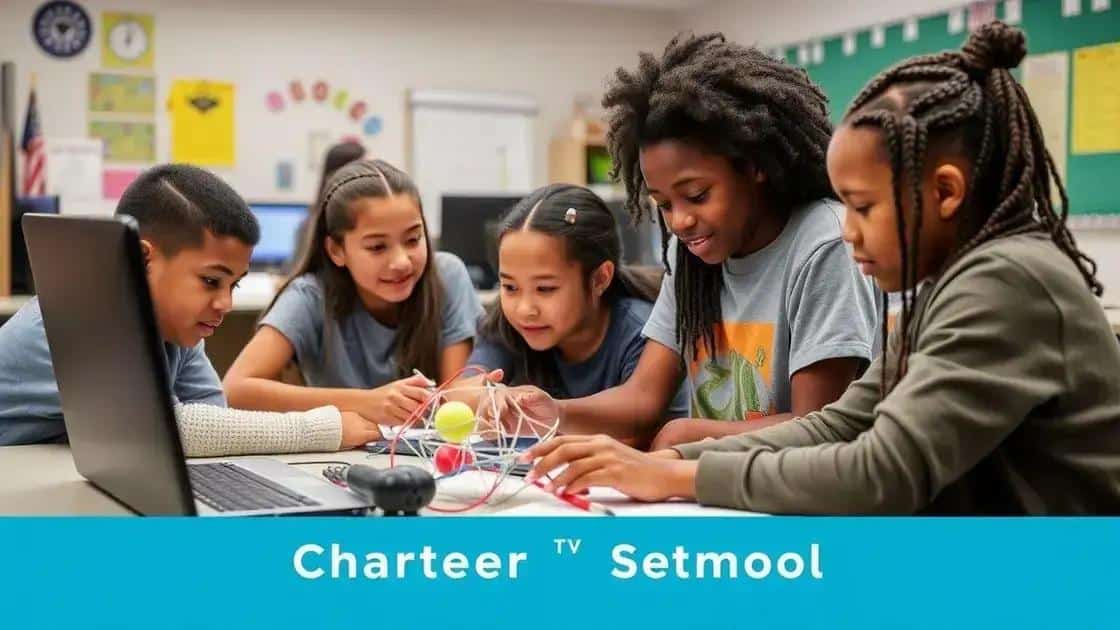Grant-funded STEM initiatives in charter schools boost education

Grant-funded STEM initiatives in charter schools enhance student engagement, improve academic performance, and prepare students for careers in technology and science through effective strategies and collaborative learning environments.
Grant-funded STEM initiatives in charter schools are transforming educational experiences for students. But what makes these programs so impactful? In this article, we’ll delve into their benefits and explore real examples that highlight their effectiveness.
Understanding grant-funded STEM initiatives
Understanding grant-funded STEM initiatives is essential for maximizing their impact on education. These programs aim to enhance science, technology, engineering, and math learning in schools. By providing financial support, schools can implement innovative projects that engage students in hands-on experiences.
What are grant-funded STEM initiatives?
Grant-funded STEM initiatives focus on developing curricula and programs that deepen students’ understanding of STEM subjects. They often encourage creativity and critical thinking. Schools apply for grants to fund activities such as:
- Robotics competitions
- Science fairs
- Engineering challenges
- Field trips to science centers
The impact of these initiatives can be profound. They often lead to improved student performance and increased interest in STEM careers.
The need for funding
Funding is vital because many charter schools operate with limited budgets. By securing grants, these schools can afford materials and technologies that may otherwise be out of reach. For instance, schools can purchase 3D printers or advanced software, allowing students to engage in contemporary learning.
Real-world examples and their effects
Several charter schools have already seen success from grant-funded initiatives. For example, one school received a grant to create a coding program. As a result, students not only learned to code but also developed problem-solving skills that benefit them across all subjects. Grant-funded STEM initiatives are bridging the gap between traditional education and modern requirements, preparing students for the future.
Benefits of STEM funding in charter schools

The benefits of STEM funding in charter schools are numerous and impactful. These funds allow schools to create tailored programs that enhance student learning in essential subjects such as science, technology, engineering, and mathematics. With increased resources, charter schools can engage students in more meaningful ways.
Enhanced Learning Opportunities
One major benefit is the development of enhanced learning opportunities. Students can participate in hands-on projects and experiments that bring classroom lessons to life. For example, they might engage in building robots or conducting chemistry experiments, which can spark a deeper interest in STEM fields.
- Access to advanced technology
- Improved laboratory facilities
- Exposure to real-world applications
- Collaborative learning environments
These experiences not only make learning fun but also develop critical thinking and problem-solving skills, key components in today’s job market.
Attracting Skilled Educators
STEM funding also helps attract skilled educators to charter schools. With better resources and support, talented teachers are more likely to join these schools. They can present innovative ways to teach complex concepts, making them more relatable for students.
Additionally, teachers can access professional development opportunities that enhance their skills and techniques. Such environments promote a culture of continuous learning for both students and educators, benefiting the entire academic community.
Fostering Diversity and Inclusion
Another important advantage is the ability to foster diversity and inclusion. Grant funding can support programs aimed at underrepresented groups in STEM fields. Charter schools can create initiatives to inspire students from diverse backgrounds to pursue STEM studies, helping to build a more inclusive future.
By providing scholarships or mentorship programs, schools can empower more students to engage in STEM learning. This not only enriches the educational experience but also leads to a broader range of perspectives in the field.
Success stories from charter schools
Success stories from charter schools showcasing the benefits of grant-funded STEM initiatives highlight how these programs can transform student experiences. Many charter schools around the country have made remarkable advancements by implementing innovative STEM projects.
Case Study: Tech Innovators Academy
One compelling example is Tech Innovators Academy. This charter school received a substantial grant to develop a comprehensive robotics program. Students engage in hands-on learning by building and programming robots. As a result, student interest in engineering fields has significantly increased. In fact, over 60% of graduates now pursue STEM majors in college.
Creative Learning Lab’s Journey
Another success comes from Creative Learning Lab. This school used grant funding to create an outdoor garden and science lab. Students conduct experiments and learn about ecology right in their neighborhood. The program not only boosts their scientific knowledge but also teaches them about environmental responsibility. Parents have reported noticeable improvements in their children’s enthusiasm for science.
- Increased academic performance
- Enhanced critical thinking skills
- Greater student engagement in classes
- Stronger community ties through projects
These success stories show that when schools invest in STEM initiatives, the benefits extend to improved educational outcomes and community involvement. Such projects foster a love of learning and curiosity among students, paving the way for future success.
Strategies for implementing STEM programs

Implementing STEM programs effectively in charter schools requires careful planning and innovative strategies. These programs should not only serve to educate but also to inspire students and engage them in the learning process.
Creating a Collaborative Environment
One core strategy involves fostering collaboration among teachers, students, and the community. By encouraging teamwork, students can learn from one another and engage deeply with the material. Teachers can collaborate to design interdisciplinary projects that bring together different STEM disciplines. This approach shows students the connections between subjects, making learning more meaningful.
Utilizing Technology
Another crucial strategy is to utilize technology effectively. This can include using educational software, simulations, or online resources. Schools should ensure that students have access to the latest tools and platforms that enhance their learning experience. For instance, introducing coding and robotics tools can spark interest in engineering and technology fields. The right technology can make complex concepts more accessible and enjoyable for students.
- Regularly update technology resources
- Provide training for teachers on new tools
- Incorporate online learning platforms
- Encourage student-led tech initiatives
In addition, schools should create hands-on experiences that connect theoretical concepts to real-world applications. Field trips to science centers, workshops with industry professionals, or community projects can reinforce learning and ignite passion for STEM subjects.
Continuous Assessment and Feedback
Lastly, implementing systems for continuous assessment and feedback is vital. Regular assessments can help educators understand student progress and adapt their teaching methods. Engaging students in self-reflection about their learning can foster a deeper understanding of their strengths and areas for improvement. This could involve project-based evaluations or peer assessments that encourage collaboration and constructive criticism.
Conclusion: As we explore the impact of grant-funded STEM initiatives in charter schools, it becomes clear that these programs are essential for fostering a love of learning and preparing students for future careers. By implementing effective strategies, such as collaboration, technology integration, and continuous assessment, charter schools can create engaging environments that inspire students. The success stories we discussed demonstrate the potential these programs have to change lives and encourage diversity in STEM fields. Overall, investing in STEM education is an investment in a brighter future for our students and our communities.
FAQ – Frequently Asked Questions about Grant-funded STEM Initiatives in Charter Schools
What are grant-funded STEM initiatives?
Grant-funded STEM initiatives are programs supported by funding to promote education in science, technology, engineering, and mathematics within schools.
How do STEM programs benefit charter schools?
STEM programs enhance student engagement, improve academic performance, and prepare students for future careers in technology and science.
What strategies can schools use to implement effective STEM programs?
Schools can promote collaboration, use technology effectively, create hands-on experiences, and establish systems for continuous assessment.
Can STEM programs help increase diversity in education?
Yes, by focusing on inclusive initiatives, STEM programs can encourage participation from underrepresented groups and promote diversity in STEM fields.





